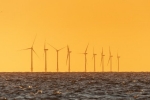
Share this article
Convergence, competition, and consolidation. The energy, utilities, and resources (EU&R) sector has it all in 2023, and we’re seeing more and more deals where businesses are converging into different sectors, or competing with new entrants as leaders focus on M&A to create value.
Meanwhile, a new wave of consolidation continues in mining, and we’ve just seen a takeover bid for Australia’s biggest gold miner. At the same time, EU&R is attracting buyers from other sectors too, and we’ve even seen carmakers cut deals for critical minerals.
Overall, expect to see plenty of capital allocated to M&A and other capital project development activity in EU&R as 2023 continues to unfold. It might just come from some surprising sources.
Overview: New entrants, but familiar drivers
Australia's EU&R sector is characterised by new entrants but some familiar themes this year. Namely, environmental, social and governance (ESG) issues continue to drive investment strategies and deal activity, just as they did last year. And the energy transition continues to be a top priority for investors and CEOs in 2023.
We’re seeing increased investment in renewables. Specifically, large-scale electrification is driving deals now more than ever before.
Security of supply is paramount for creating value. Prudent dealmakers are adding upstream material suppliers to their portfolios to secure certainty on price and volume, and to guarantee ESG provenance.
Mining companies are eyeing up gas companies; oil and gas companies are looking at renewables. Convergence across sectors and into EU&R is accelerating in 2023.
Current landscape: 5 biggest trends in dealmaking right now
Deal volumes were down slightly in Australia in 2022 (207 EU&R deals were completed, down from 271 deals in 2021), while values dropped to $27,490m (down from $40,684m in 2021).
Behind those headline figures, we’ve observed five trends that are shaping investment activity in Australia’s EU&R sector:
- Diversification: EU&R players are broadening their horizons – and diversifying their businesses. For instance, we’ve seen a spike in interest in copper, driven by demand for electrification, and Australia, with the second largest copper reserves of any nation, is set to benefit.
- Carve-outs: More popular than ever before, carve-outs and non-core asset sales are offering an alternative way to unleash value during the energy transition.
- Policy: Energy policy seen right across the globe, is being felt here at home. We only need to look at 2022’s temporary price caps on uncontracted gas, and the mandatory code of conduct for gas prices, to see the effect of regulatory pressure on deal activity. Further energy price caps and export controls have been mooted, adding to uncertainty across the sector.
- Convergence: Mining companies are eyeing up gas companies. Oil and gas companies are looking at renewables. Convergence across sectors and subsectors of the EU&R sector is accelerating in 2023, as companies reshape their asset portfolios in response to the energy transition. Dealmakers need to consider whether the opportunities to expand into adjacent energy sub-sectors aligns with their strategy, where they want to play and importantly that the risk/ return trade-off aligns to their investment criteria.
- Competition: It’s not just the usual EU&R players straying outside their lanes, either. The sector is attracting new buyers from other sectors such as industrial companies.
Market outlook for 2023: ESG continues to drive deals
ESG will continue to be an enormous focus of deal activity in the EU&R sector this year as organisations – and investors – put ESG at the core of their strategic agendas. As demand grows for clean technologies such as renewables, critical minerals, carbon capture, and transmission infrastructure, here’s what dealmakers in the sector can expect to see:
Mining
Decarbonisation continues to create insatiable demand for Australia’s critical minerals. Strategic partnerships will continue to be on the agenda for majors, while industrial players will seek direct ownership or direct offtake arrangements with critical minerals producers and developers.
Meanwhile, a new wave of consolidation continues in Australia’s mining industry, especially within the gold sector and particularly at the junior end. We expect further consolidations amid a globally competitive market, and as business leaders focus on acquisitions to create value.
Oil and gas
Australia’s domestic gas appetite continues as mines try to access and secure gas supplies in the face of rising energy prices, and as the transition to clean energy proves a marathon (not a sprint).
Expect strong cash flow from hydrocarbons to continue to feed low-carbon investment opportunities such as renewables, EV charging, biofuels, and hydrogen. Speaking of hydrogen: new investors in gas infrastructure are seeking hydrogen opportunities, especially midstream (such as hydrogen vending for heavy goods vehicles).
Meanwhile, trading houses will to continue divesting minority stakes in LNG and coal projects, and to increase their investment in renewables. Similarly, many pension funds are pivoting from hydrocarbons to renewables.
Power and utilities
In 2023, we’ll see an increasingly diverse marketplace, across different aspects of the power and utilities value chain, as government policy and ESG agendas drive investment strategies and deal activity.
In the case of renewables such as wind and solar, we’ve seen a consolidation by several platforms backed by pension funds and specialised infrastructure funds, together with new offshore entrants backed by global energy companies. Given the need for increased renewable generation, and the required capital deployment, expect to see inbound interest continue.
Meanwhile, the investment in firming capabilities (e.g. batteries) has yet to take off in a really meaningful way. This is largely due to the uncertainty of revenue on such projects, and to date successful projects have generally been greenfield projects, supported by state government initiatives and offtake contracts. Similarly, newer technologies (e.g. biofuels, hydrogen) remain at pilot stages.
However, the investment community is generally accepting of the short-to-medium term planned exit of coal-fired generation, and the need for new technologies. We’re seeing the emergence of several specialist energy transition funds who are keen to invest in the sector. We expect such funds to continue to seek opportunities.
The electricity grid needs substantial investment to expand the network from historical (centralised) coal-fired generation locations and connect to a much wider distribution of solar and wind generation facilities. The need for capital and regulatory returns will undoubtedly change the current ownership model in some jurisdictions.
As an example, the NSW Renewable Energy Zones (REZ) have attracted PPP consortia keen to invest in the sector and roll out the required network connections, and the capital requirement is likely to influence the NSW government when it comes to the potential privatisation of the remaining poles and wires still under state ownership.
Finally, increases to the wholesale cost of gas and electricity have placed (mainly smaller and unhedged) retailers under margin pressure, and several have withdrawn from the sector or been constrained in growth ambitions or been acquired by larger players. This trend is likely to continue. However, deals volume may be modest, as largely players seek to pick up customers via natural attrition from others, rather than paying a premium to acquire customer books.
Large-scale electrification is driving deals now more than ever before. At the same time, security of supply is paramount for creating value.
What's next for dealmakers?
Where the value creation opportunities lie
Savvy dealmakers will seek value creation opportunities in the following areas this year:
- Critical minerals: From strategic partnerships to direct ownership or offtake arrangements, critical minerals will continue to live up to their name and prove critical again this year.
- Mass market electrification investment: The fact that the Tesla Model 3 is the best-selling car in Australia so far in 2023 says it all. Residential decarbonisation is a major market. Expect investments in the e-mobility value chain to remain high as energy providers and utilities look to maximise value.
- Hydrogen: Plenty of capital is flowing to hydrogen projects right now. In time, these projects will either expire or mature – and the mature ones will trade, so watch this space.













